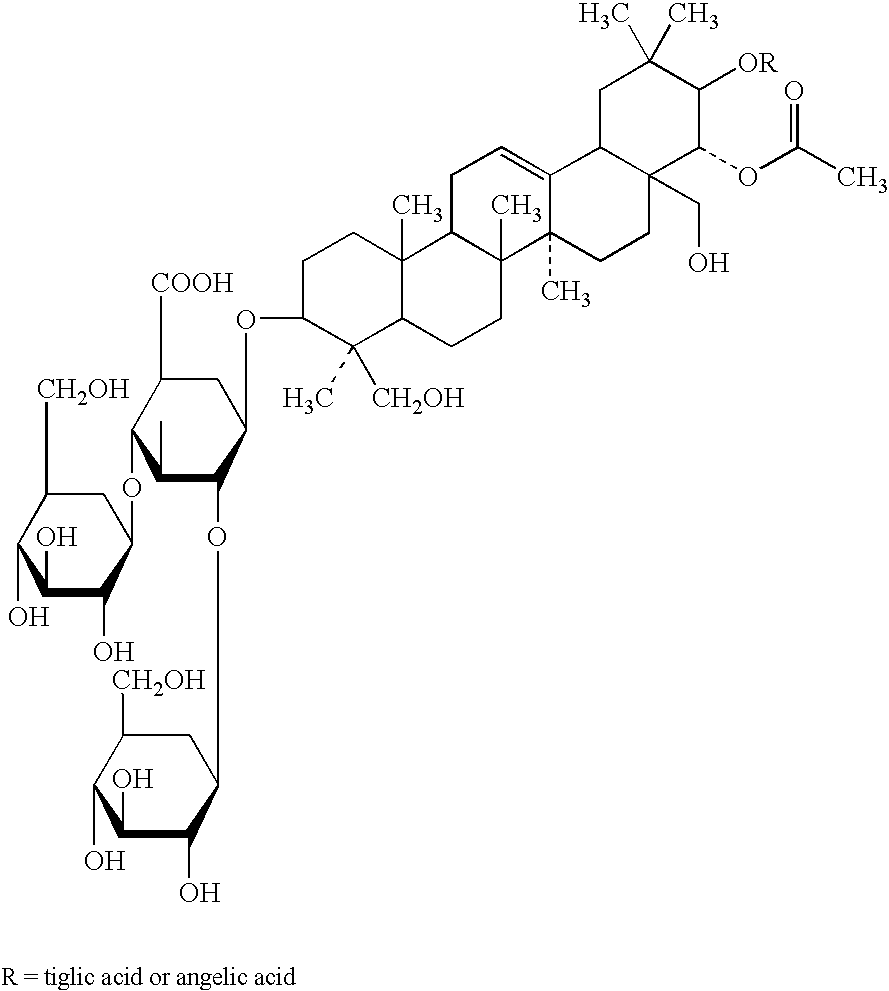Use of physiologically active fatty acids
a technology fatty acids, which is applied in the field of physiologically active fatty acids, can solve the problems that none of the actives or compositions have been found to give satisfying effects
- Summary
- Abstract
- Description
- Claims
- Application Information
AI Technical Summary
Problems solved by technology
Method used
Image
Examples
example 1
Production of Microcapsules Containing CLA
[0030] Two solutions, one containing 2.8% b.w. gelatin (Geltec® SG-730 N, Extraco) and one containing 1.2% b.w. sodium carboxymethylcellulose (DS-07, Aldrich, MW=90.000) and 1.5% b.w. conjugated linoleic acid (Tonalin® CLA, Cognis) were prepared in distilled water at 45° C. Both solutions were adjusted to pH 6.5 using a 1 N NaOH solution. The CMC solution was added to the solution containing the gelatin, and dispersed using Ultra Turrax equipment. Thereafter, the pH was adjusted to 4.25 using a 1 N HCl solution and the mixture was cooled down to 25° C. under stirring. Subsequently, the formation of coacervates was recognized by increasing turbidity. The so-formed coacervates were hardened by adding glutaraldehyde under stirring. After a reaction time of 4 h at 25° C., the coacervates thus obtained were filtered off using a Buchner funnel and stored at 5° C. as a slurry. The average particle size was 12.8 μm.
example 2
Production of Microcapsules Containing CLA and Castanea saliva Extract
[0031] Two solutions, one containing 2.5% b.w. gelatin (Geltec® SG-730 N, Extraco) and one containing 1.3% b.w. sodium carboxymethylcellulose (AV 27088D, Aldrich, MW=ca. 38.000), 1.2% b.w. conjugated linoleic acid (Tonalin® CLA, Cognis) and 0.5% b.w. of a spray-dried extract of Castanea sativa (Herbalia® Horse chestnut, Cognis) were prepared in distilled water at 45° C. Both solutions were adjusted-to-pH 6.5 using a 1 N NaOH solution. The CMC solution was added to the solution containing the gelatin and dispersed using Ultra Turrax equipment. Thereafter, the pH was adjusted to 4.25 using a 1 N HCl solution and the mixture was cooled down to 25° C. under stirring. Subsequently, the formation of coacervates was recognized by increasing turbidity. The so-formed coacervates were hardened by adding glutaraldehyde under stirring. After a reaction time of 4 h at 25° C., the coacervates thus obtained were filtered off u...
example 3
Production of Microcapsules Containing Omega-3
[0032] Two solutions, one containing 2.8% b.w. gelatin (Geltec® SG-730 N, Extraco) and one containing 1.2% b.w. sodium carboxymethylcellulose (DS-07, Aldrich, MW=90.000) and 1.5% b.w. w-unsaturated fish fatty acid (Omacor®, Pronova) were prepared in distilled water at 45° C. Both solutions were adjusted to pH 6.5 using a 1 N NaOH solution. The CMC solution was added to the solution containing the gelatin and dispersed using Ultra Turrax equipment. Thereafter, the pH was adjusted to 4.25 using a 1 N HCl solution, and the mixture was cooled down to 25° C. under stirring. The so-formed coacervates were hardened by adding glutaraldehyde under stirring. After a reaction time of 4 h at 25° C. the coacervates thus obtained were filtered off using a Buchner funnel and stored as a slurry at 5° C. The average particle size was 12.5 μm.
PUM
| Property | Measurement | Unit |
|---|---|---|
| Composition | aaaaa | aaaaa |
| Weight ratio | aaaaa | aaaaa |
| Pharmaceutically acceptable | aaaaa | aaaaa |
Abstract
Description
Claims
Application Information
 Login to View More
Login to View More - R&D
- Intellectual Property
- Life Sciences
- Materials
- Tech Scout
- Unparalleled Data Quality
- Higher Quality Content
- 60% Fewer Hallucinations
Browse by: Latest US Patents, China's latest patents, Technical Efficacy Thesaurus, Application Domain, Technology Topic, Popular Technical Reports.
© 2025 PatSnap. All rights reserved.Legal|Privacy policy|Modern Slavery Act Transparency Statement|Sitemap|About US| Contact US: help@patsnap.com

